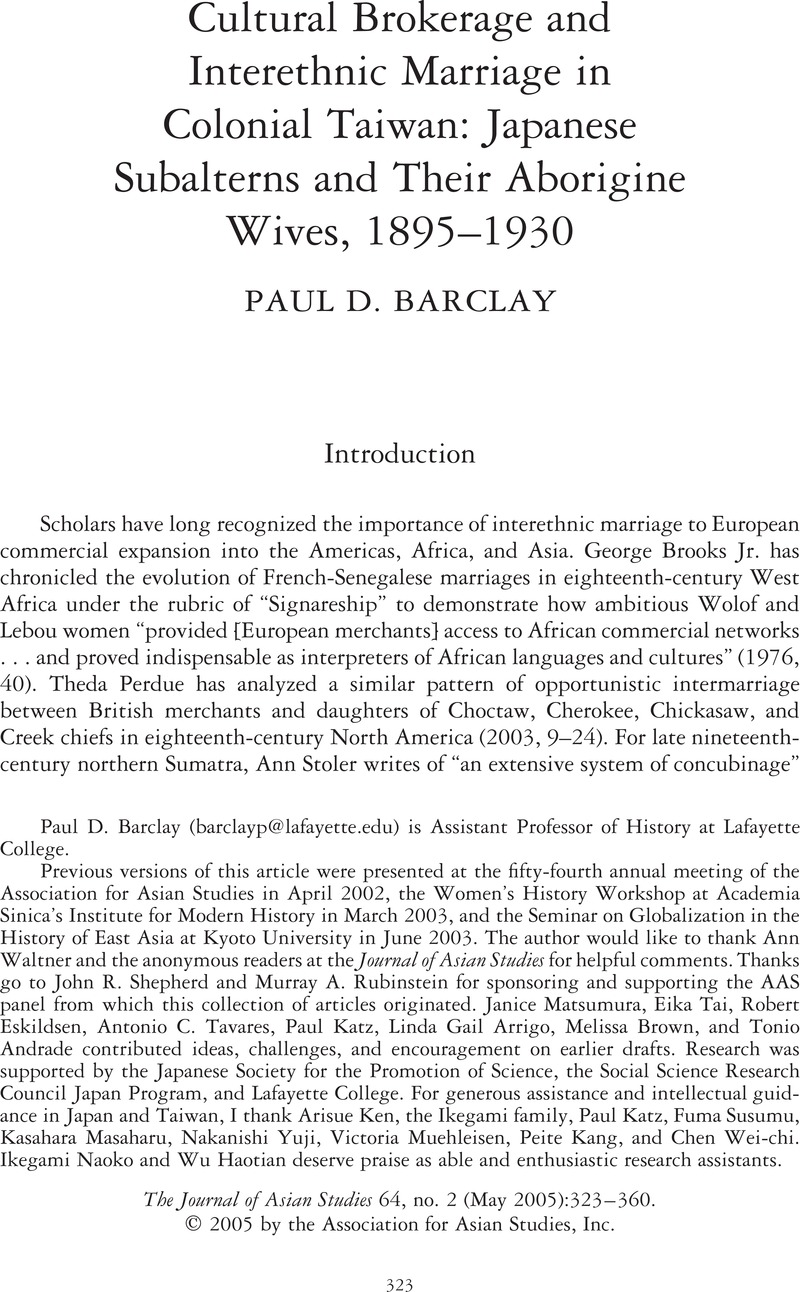Crossref Citations
This article has been cited by the following publications. This list is generated based on data provided by Crossref.
Katz, Paul R.
2005.
Governmentality and Its Consequences in Colonial Taiwan: A Case Study of the Ta-pa-ni Incident of 1915.
The Journal of Asian Studies,
Vol. 64,
Issue. 2,
p.
387.
Eskildsen, Robert
2005.
Taiwan: A Periphery in Search of a Narrative.
The Journal of Asian Studies,
Vol. 64,
Issue. 2,
p.
281.
Hartley, Ralph
2010.
Sleeping with the enemy: an essay on mixed identity in the context of violent conflict.
Social Identities,
Vol. 16,
Issue. 2,
p.
225.
SIMON, SCOTT
2010.
Negotiating power: Elections and the constitution of indigenous Taiwan.
American Ethnologist,
Vol. 37,
Issue. 4,
p.
726.
Barclay, Paul D.
2010.
Peddling Postcards and Selling Empire: Image-Making in Taiwan under Japanese Colonial Rule.
Japanese Studies,
Vol. 30,
Issue. 1,
p.
81.
Sterk, Darryl
2014.
Ironic indigenous primitivism: Taiwan's first ‘native feature’ in an era of ethnic tourism.
Journal of Chinese Cinemas,
Vol. 8,
Issue. 3,
p.
209.
Manickam, Sandra
2014.
Bridging the Race Barrier: Between “Sakai” and “Malay” in the Census Categorisations of British Malaya.
Asian Studies Review,
Vol. 38,
Issue. 3,
p.
367.
Heé, Nadin
2014.
Taiwan under Japanese Rule. Showpiece of a Model Colony? Historiographical Tendencies in Narrating Colonialism.
History Compass,
Vol. 12,
Issue. 8,
p.
632.
Tai, Eika
2014.
Intermarriage and imperial subject formation in colonial Taiwan: Shōji Sōichi'sChin-fujin.
Inter-Asia Cultural Studies,
Vol. 15,
Issue. 4,
p.
513.
Ziomek, Kirsten L.
2015.
The Possibility of Liminal Colonial Subjecthood: Yayutz Bleyh and the Search for Subaltern Histories in the Japanese Empire.
Critical Asian Studies,
Vol. 47,
Issue. 1,
p.
123.
Hirano, Katsuya
Veracini, Lorenzo
and
Roy, Toulouse-Antonin
2018.
Vanishing natives and Taiwan’s settler-colonial unconsciousness.
Critical Asian Studies,
Vol. 50,
Issue. 2,
p.
196.
Dawley, Evan N.
2018.
Finding Meaning in Time and Space: Periodisation and Taiwanese-centric History.
International Journal of Taiwan Studies,
Vol. 1,
Issue. 2,
p.
245.
Roy, Toulouse Antonin
2019.
“The Camphor Question Is in Reality the Savage Question”: Indigenous Pacification and the Transition to Capitalism in the Taiwan Borderlands (1895–1915).
Critical Historical Studies,
Vol. 6,
Issue. 1,
p.
125.
Hirano, Katsuya
Veracini, Lorenzo
and
Roy, Toulouse-Antonin
2021.
Indigenous Knowledge in Taiwan and Beyond.
Vol. 1,
Issue. ,
p.
225.
Roy, Toulouse Antonin
2022.
War in the camphor zone: Indigenous resistance to colonial capitalism in upland Taiwan, 1895–1915.
Japan Forum,
Vol. 34,
Issue. 3,
p.
333.
Darby, Alison J.
2023.
Managing Marriage: Advice Columns and Interethnic Intimacy in Colonial Taiwan.
Asian Studies Review,
Vol. 47,
Issue. 2,
p.
227.



 , ed.
, ed. 